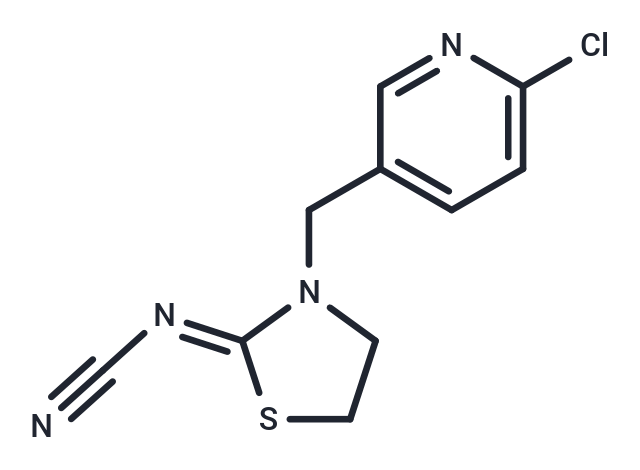Shopping Cart
- Remove All
 Your shopping cart is currently empty
Your shopping cart is currently empty

Thiacloprid, a chloronicotinyl insecticide, acts as a selective agonist at insect nAChRs. The IC50 values are 2.7 and 860 nM for Drosophilan AChRs and M10 mouse fibroblast cells expressing α4β2 subunit-containing nAChRs, respectively.

| Pack Size | Price | Availability | Quantity |
|---|---|---|---|
| 100 mg | $37 | In Stock |
| Description | Thiacloprid is a neonicotinoid insecticide that acts as a selective agonist at insect nicotinic acetylcholine receptors (nAChRs) with IC50values of 2.7 and 860 nM forDrosophilanAChRs and M10 mouse fibroblast cells expressing α4β2 subunit-containing nAChRs, respectively.1It is active against aphids, whiteflies, various species of beetle, andLepidopteraspecies when used at concentrations ranging from 48 to 180 g AI/hectare.2It has anti-estrogenic activity in a yeast estrogen screen and is toxic to adult female houseflies and mice (LD50s = 0.03 and 28 mg/kg, respectively).1,3Formulations containing thiacloprid have been used in the control of insects in agriculture. 1.Tomizawa, M., and Casida, J.E.Selective toxicity of neonicotinoids attributable to specificity of insect and mammalian nicotinic receptorsAnnu. Rev. Entomol.48339-364(2003) 2.Elbert, A., Erdelen, C., Kuhnhold, J., et al.Thiacloprid, a novel neonicotinoid insecticide for foliar applicationProc. Brighton Crop. Prot. Conf. - Pests and Diseases121-26(2000) 3.Westlund, P., and Yargeau, V.Investigation of the presence and endocrine activities of pesticides found in wastewater effluent using yeast-based bioassaysSci. Total Environ.607-608744-751(2017) |
| Targets&IC50 | α4β2 nAChR:860 nM(M10 mouse fibroblast cells), α4β2 nAChR:2.7 nM(Drosophilan) |
| Molecular Weight | 252.72 |
| Formula | C10H9ClN4S |
| Cas No. | 111988-49-9 |
| Smiles | Clc1ccc(CN2CCS\C2=N/C#N)cn1 |
| Relative Density. | 1.424g/cm3 |
| Storage | Powder: -20°C for 3 years | In solvent: -80°C for 1 year | Shipping with blue ice. | |||||||||||||||||||||||||||||||||||
| Solubility Information | Methanol: Slightly soluble DMSO: 55 mg/mL (217.63 mM), Sonication is recommended. Chloroform: Slightly soluble | |||||||||||||||||||||||||||||||||||
Solution Preparation Table | ||||||||||||||||||||||||||||||||||||
DMSO
| ||||||||||||||||||||||||||||||||||||

Copyright © 2015-2025 TargetMol Chemicals Inc. All Rights Reserved.